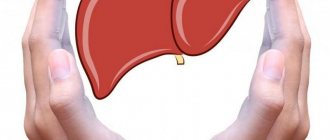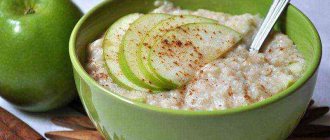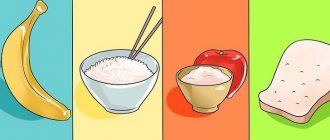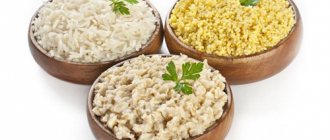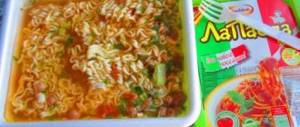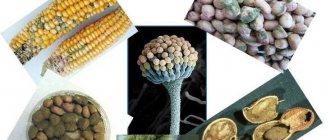Nutrition for diarrhea
General description of the disease
Diarrhea is a symptom of an intestinal disorder (diarrhea), which is characterized by frequent loose stools.
Causes of acute diarrhea:
drinking contaminated unboiled water, allergies to medications or food, intolerance to lactose or other foods, bacterial, parasitic or viral intestinal infections (amoebiasis, food poisoning, stomach flu), emotional disorders and stress.
Causes of chronic diarrhea:
Crohn's disease, irritable bowel syndrome, chronic inflammation, ulcerative colitis, rectal and colon ulcers, malabsorption syndrome, rectal cancer.
Symptoms of diarrhea:
frequent bowel movements, high body temperature, nausea, vomiting, blood in the stool, severe constant pain in the abdomen, dehydration (feeling thirsty, dry tongue and lips, infrequent urination, rapid breathing).
Cruciferous vegetables
Vegetables such as cauliflower, broccoli, radishes, and cabbage (including the sauerkraut version) can increase symptoms of diarrhea. They all contain complex carbohydrates that are difficult to digest. In addition, these vegetables are rich in fiber, which can aggravate diarrhea and flatulence. In addition to cruciferous vegetables, it is advisable to limit the consumption of artichokes, greens, lettuce, asparagus and onions.
Healthy foods for diarrhea
A diet for diarrhea aims to restore the intestinal microflora and resume its function of absorbing excess fluid. Diet No. 4 is usually recommended, which aims to calm the mucous membrane and reduce fermentation processes in the intestines. Food should be steamed or boiled and pureed. Warm semi-liquid and liquid foods should be included in the diet. Thus, limiting the effects on the intestines of chemical, mechanical and thermal irritants.
In the first few hours of the development of diarrhea, special attention should be paid to the drinking regime, since the disease severely dehydrates the body and “washes out” minerals and salts. Drinks with beneficial properties for diarrhea include: apple juice, black tea with lemon juice, herbal tea, raspberry leaf tea, salt solutions “Regidron”, “Gastrolit”, warm alkaline non-carbonated mineral water, decoctions of raisins, blueberries, rose hips .
Among the products, the most useful are:
- boiled white rice (poor in fiber and has “binding” properties), eat half a cup once every two hours;
- banana (rich in potassium, which is “washed out” from the body during diarrhea), eat two bananas every 4 hours;
- liquid porridge with water (buckwheat, rice, oatmeal, semolina);
- white bread in the form of crackers;
- soft-boiled eggs, steam omelet, pureed cottage cheese - to replenish proteins;
- boiled, grated, baked apples (contain pectin, tannin and organic acids, which binds toxins and helps restore intestinal microflora);
- grated carrots and carrot puree (contains vitamin A, which improves the condition of the intestinal mucosa and has adsorbing effects);
- “slimy” soups with meatballs in low-fat fish/meat broth;
- lean fish and meat without bones, tendons and skin (for example, steamed cutlets);
- vegetable decoctions and purees;
- jelly and jelly from blueberries, pears, bird cherry and quince.
Sample one-day menu for diarrhea
Early breakfast: oatmeal, unsweetened green tea. Late breakfast: quince compote. Lunch: rice meat broth, buckwheat porridge with water, steamed meatballs, jelly. Afternoon snack: rosehip decoction. Dinner: steam omelette and tea. At night: jelly.
Traditional recipes for diarrhea
- To replenish the water-salt balance of the body, you can use the following “cocktail”: half a liter of water, one quarter teaspoon of salt, one quarter teaspoon of soda, two tbsp. spoons of honey, take 1.5 liters per day;
- for bacterial diarrhea: half a teaspoon of garlic juice every two hours;
- canned or fresh aloe juice - take two spoons three times a day half an hour before meals;
- birch tincture (pour half a bottle of birch buds with vodka, seal tightly, leave for a month in a warm place, shaking occasionally) take 40 drops three times a day;
- juice from shepherd's purse grass, take 40 drops per fifty grams of vodka in two doses;
- fresh bird cherry juice;
- Bird cherry decoction (15 grams of bird cherry per 200 milliliters of water, boil for 5 minutes, leave) take in two doses.
Dangerous and harmful foods for diarrhea
Limit intake of citrus, pineapple or tomato juice, which additionally cause intestinal irritation. And also, foods that increase the symptoms of diarrhea: processed foods, fatty foods, sweets, sugar, chewing gum, drinks with sorbitol, coffee, milk, legumes, brown bread and baked goods, beets, sauerkraut, cucumbers, radishes, plums, radishes , fruit juices, grapes, yoghurts, cream, fermented baked milk, cottage cheese, kefir, cheese, fatty meats, poultry, fish, caviar, concentrated fish and meat broths, alcohol, pasta, millet and barley groats, marinated, smoked, salted and canned foods (sausages, sausage, brisket, pickled cucumbers and tomatoes, olives), honey, jam, chocolate, raw fruit, fried or hard-boiled eggs, sauces, herbs and spices.
source
Effect on the body
White chocolate is considered the most healthy - it does not contain cocoa bean cake, it contains only cocoa butter. True, people sometimes get diarrhea from white chocolate, since this sweetness may contain milk powder. This product is not digestible in patients with lactose intolerance, which, in turn, provokes digestive upset.
But white chocolate has many beneficial properties, especially if the bar does not contain foreign additives or their content is minimal.
The effect of cocoa butter on the human body:
- Stimulates brain function (with the help of caffeine).
- Elevates mood (due to dopamine, tryptophan).
- Tones (the effect of theobromine).
When deciding whether it is possible to eat chocolate during diarrhea, the patient can pay attention to the effect that the dessert has directly on the intestines. Some experts believe that cocoa has a positive effect on the qualitative and quantitative growth of the saprophytic flora of the gastrointestinal tract. Bifidobacteria and lactobacilli ferment chocolate components, promoting the formation of new compounds believed to have anti-inflammatory properties.
You can enhance the positive effects of chocolate for diarrhea on the intestines and the entire body. For this purpose, it is advisable to consume the cocoa product with pomegranate and acaya.
Important! Theobromine, which is part of chocolate, is a substance that invigorates and helps relieve fatigue.
Cocoa has a positive effect on the functioning of the circulatory system, preventing the development of atherosclerosis and stroke. Dark chocolate improves the elasticity of blood vessels and helps prevent the formation of blood clots. You just need to take into account that chocolate products are quite high in calories. Eating desserts in large quantities can lead to negative effects – weight gain, obesity, and disruption of the cardiovascular system.
Beware of diarrhea: what foods can you eat if you have diarrhea?
Diarrhea is a common stomach upset that affects both adults and children. Despite the fact that diarrhea is quite common, it should not be considered harmless to health. The appearance of diarrhea can be preceded by various, sometimes life-threatening, causes, therefore, it is important to identify and eliminate them in a timely manner.
Treat for children
Pediatricians told us whether children can have chocolate and at what age it should be given to children. According to them, this product should not be included in the diet of a child under 3 years of age. Chocolate is not only an aggressive allergen, it greatly excites the child’s nervous system. In addition, chocolate contains sugar, which has a detrimental effect on tooth enamel (causing caries and other complications). A large amount of this delicacy causes diathesis and allergies. Sweets put a lot of stress on the liver, so giving them to children is not recommended.
Starting from 3 years of age (as directed by a doctor from 2 years of age), a healthy amount of chocolate is 100 g per week, no more! In small doses, chocolate is healthy, as it contains antioxidants that improve metabolism and the so-called happiness hormone.
Diarrhea - when to sound the alarm
Can diarrhea be considered harmless to health? The answer is not in all cases. In fact, diarrhea in an adult or child is often caused either by an intestinal reaction to a food or by a serious illness. Moreover, the disease does not necessarily have to be associated with a disorder of the digestive system. These could be mental disorders or cancer.
But mostly diarrhea occurs due to poor eating habits. We often eat foods that our digestive organs accept with increased sensitivity. Also, sometimes the combination of some products is incompatible (for example, if you eat dumplings and wash them down with milk). Subsequently, diarrhea begins.
If you are experiencing diarrhea specifically because of a food intolerance or incompatibility, you need to determine which foods trigger your diarrhea. Then, replace them with food that you can eat during diarrhea and to prevent it. Sometimes overuse of products with laxative properties can also lead to diarrhea. If your breakfast, lunch and dinner consist of 90% only fermented milk products, fresh vegetables and fruits, the cause of diarrhea lies precisely in your diet.
You should sound the alarm for diarrhea when you have bowel movements with a frequency of 3-6 times a day for a long period (from 3 to 7 days). Prolonged diarrhea is often accompanied by other symptoms, such as malaise, vomiting, and fever. It is important to pay attention to the consistency and color of stool. There may be bloody discharge or mucus on them. These are not good signs. In this case, self-medication of diarrhea is strictly prohibited. You need to see a doctor urgently
The causes of prolonged diarrhea are:
- Emotional shocks (stress, nervous breakdown, fear).
- Intestinal, bacterial and viral infections.
- Presence of parasites in the intestines.
- Allergy to medications.
Prolonged diarrhea leads to dehydration. To prevent large loss of fluid in the body, it is important to maintain a drinking regime. On average, an adult is allowed to drink 2 liters of purified water per day, a child - 1.5 liters. The consumption of tea, coffee, juices and even the most watery berry such as watermelon is not taken into account
Symptoms of lack of fluid in the body are:
- General fatigue.
- Confusion.
- Headache.
- Feeling thirsty.
- Dryness of the mucous membranes of the mouth, nasal passages and eyes.
- Urine is dark yellow.
If you suddenly develop diarrhea and at the same time notice other symptoms that negatively affect your well-being, consult a doctor immediately. In such cases, self-medication and assumptions that things will get better in a couple of days can only worsen health problems.
What you can and cannot eat when you have diarrhea
Compliance with an individual diet is a prerequisite for the treatment of prolonged diarrhea. It is necessary to create a therapeutic diet of foods that can be eaten during diarrhea, and exclude from it those foods that are prohibited to eat during diarrhea.
Let's look at foods that you shouldn't eat:
- Fatty food. This includes foods cooked with large amounts of vegetable/animal oil or flavored with sauces.
- Milk and its derivatives: butter, cheese, ice cream, kefir, sour cream, fermented baked milk and yogurt. Stay away from dairy products, even if you don't have lactose intolerance issues. During diarrhea, the intestines become more sensitive to dairy products, which can make the diarrhea worse.
- Alcoholic and caffeinated drinks are not allowed during diarrhea, because they are “diuretics” - fluid absorbers that lead to dehydration.
- Vegetables, berries and fruits with a high content of natural acids. Strawberries, cherries, grapes, pears, tomatoes, onions, sweet peppers and all varieties of cabbage cause flatulence, bloating and diarrhea. Citrus fruits such as lemons, oranges and grapefruits stimulate fermentation and gases in the intestines.
- Baked goods, chocolate and candies. Products containing artificial sweeteners have laxative properties.
- Nuts (walnuts, hazelnuts and almonds). These foods contain fats and insoluble fiber that loosen stools. Eating a handful of these nuts will only make your diarrhea worse.
- Sunflower and flax seeds. These seeds, like nuts, have a laxative effect on the digestive system.
Be careful when choosing meat and fish, especially in hot weather. If they have not been stored properly in the store, they may become infected with a parasitic infection.
- Lean meat (chicken, turkey).
- Chicken eggs without yolks.
- Probiotic yogurt.
- Low-fat fish (perch, crucian carp, herring, hake, pollock).
- Lean rice.
- Potatoes (mashed potatoes).
- Dietary vinaigrette.
- Pasta.
- Bananas.
- Apples.
- Watermelon.
- Quince.
Quince is considered effective in treating diarrhea if used correctly for this purpose. As you know, quince contains a tart and very sour taste. Therefore, it is not recommended to take it raw. However, it makes a useful tincture. If quince grows in your area, be sure to use it as a medicine for diarrhea. Before using the infusion, consult your doctor. Perhaps you may have more serious causes of diarrhea, and the quince drink will be powerless
How to prepare an infusion? To do this you need fresh quince - 200 g and 1 liter of hot water. Place the fruit in a glass bottle and pour boiling water over it. Leave for about an hour. Take the drink warm, 200 ml in one dose every hour until the diarrhea stops.
Recommended drinks
During the treatment of diarrhea and during the recovery period, maintaining the correct fluid balance in the body is extremely important. Pure water without gas becomes a mandatory drink for the entire period of treatment. It may be slightly enriched with minerals.
After the end of acute symptoms, it is worth drinking fruit drinks (strawberry, blueberry, lingonberry), compotes (from pears, apples, dried fruits), tea (black, herbal). It is important to drink fermented milk drinks (whey, ayran, kefir). Eating jelly is also acceptable. The most healthy and delicious are milk jelly, raspberry, cranberry, strawberry and cherry jelly.
What foods to eat for diarrhea?
Intestinal disorders require a special diet. In most cases, a proper diet will help get rid of diarrhea fairly quickly.
What should you eat if you have diarrhea?
1. During an intestinal disorder, potassium is removed from the body, which bananas will help replenish. Potato dishes (mashed potatoes or jacket potatoes) and fruit juices will not be superfluous.
2. Hard-boiled eggs and dietary chicken or turkey meat are excellent for diarrhea. They are rich in proteins and help the body recover faster.
3. Include porridge cooked in water in your diet. Rice and oatmeal help best - they have a beneficial effect on the stomach and intestines, helping to remove toxins.
4. Be sure to consume light soups or broths - if you have diarrhea, it is important to avoid dehydration.
Compound
Before consuming chocolate for diarrhea, you should study its composition. It contains many useful substances that have a positive effect on the body. Both milk and bitter products are quite high in calories; 100 g of milk chocolate contains 550 kcal, 100 g of bitter chocolate contains 540 kcal, so they satisfy hunger well.
The main component of chocolate is cocoa butter. It is supplemented with dry ground cocoa and additives:
- Sugar.
- Flavors.
- Cream.
- Nuts.
- Almond, soy, coconut milk (for vegans).
- Sorbitol, xylitol (for diabetics).
The product may also contain other components that improve the taste of the dessert. But it is cocoa beans that contain active substances that have an effect on the body: dopamine, antioxidants polyphenol and epicacetin, trace elements magnesium, potassium and others. Cocoa also contains tannins - approximately 6% of the total components are tannin (a substance that helps harden stool).
Prohibited foods for diarrhea
If you have an intestinal disorder, you don’t really want to look at food. At this moment, the body, if it requires food, requires a specific one. However, not all foods can be consumed during diarrhea and the next 3-4 days after it. These include:
- all fatty and fried foods, hard on the stomach and intestines. Taking it can only worsen the condition.
— dairy products, except yogurt, are also undesirable for diarrhea.
- Avoid eating foods that cause gas accumulation. Carbonated drinks, cabbage, and cucumbers should be excluded from the diet.
— there is a ban on canned and smoked meats and fast food.
It is important not to forget about the temperature regime of the products consumed. Food should be warm, since cold food is difficult to digest, and hot food irritates the gastrointestinal tract.
If the condition improves, the diet can be gradually expanded, switching after a week to the usual nutritious diet.
By the way, diarrhea can be one of the symptoms of an intestinal infection. This problem is especially acute during the holidays, since high air temperatures promote the proliferation of pathogenic microorganisms.
source
Basic principles of the diet
The most gentle option for treating diarrhea is to streamline your diet, which is based on the following principles:
- To avoid dehydration, drink more, the liquid should be mostly warm at room temperature (optimally - 300-400 ml every half hour), use 6-8 grams of table salt for solutions.
- Eliminate all fermented products from the diet.
- Refuse food with the effect of increasing bile secretion.
- Eat more often, in minimal portions (if possible, every 3 hours).
- Avoid any intestinal irritants.
- Eat fully (about 2000 Kcal per day), while bringing the amount of fats and carbohydrates to a tolerable norm for the physiology of the body (the reduction does not apply to proteins).
- Do not eat “forcefully” if you have no appetite.
- Prepare all dishes liquid, semi-liquid, boil or steam food.
When and how to eat if you have diarrhea:
1. Try a diet with clear liquids (water, weakly brewed tea, apple juice, light broth, ice cream or plain gelatin). Clear liquids obstruct bowel movements and help prevent irritation.
2. Eat small, frequent meals. Your body will be able to digest smaller amounts of food more easily.
3. On day 2 of diarrhea, you should start a liquid diet and add low fiber foods. This will help relieve bowel irritation and bring you some nutrients.
4. Drink at least one cup of liquid after each bowel movement to avoid becoming dehydrated.
Folk remedies
In folk medicine there are many remedies that will help with diarrhea after each meal. It should be noted right away that such remedies are safe, but they will not bring quick results, unlike medications.
Traditional medicine recipes are recommended to be combined with other therapies. Among the effective recipes are:
- Infusion of oak bark. Need for 1 tbsp. add 250 ml of boiling water to the crushed bark and leave for half an hour. Drink the product after each meal in equal parts.
- Peppermint infusion. Place 1 tbsp in a cup. dried or fresh plants and add boiling water, leave for 20 minutes, then drink half a cup every couple of hours.
- Infusion of carrot seeds. The seeds must be ground into powder. You need to take 1 tsp. dry powder with a glass of water. The product should be used after every meal.
- Cumin infusion. Place 2 tbsp in a cup. caraway seeds, add boiling water and leave to brew for 20 minutes. Take 50 ml 3 times a day after meals. Suitable for treating a child.
Although traditional medicine methods are safe and natural, before using them it is better to consult a doctor and undergo an examination, because diarrhea after eating can indicate serious abnormalities.
What can you eat if you have diarrhea?
1. Consume foods rich in pectin, such as apple compote, bananas and yogurt. Pectin helps reduce diarrhea.
2. Eat foods rich in potassium, which include fruit juices, sports drinks, peeled potatoes and bananas. During diarrhea, potassium is usually lost.
3. High sodium foods will help with diarrhea. These include soups, broths, and salty crackers. Salt helps retain water and avoid dehydration.
4. You can also eat small amounts of lean red meat, pork, turkey or chicken. Hard-boiled eggs and tofu also help. Such products will fill the body with energy, which will avoid fatigue.
5. If you like certain vegetables and fruits, eat them baked or boiled, rather than raw. Some raw vegetables and fruits can make diarrhea worse. Try soups made with asparagus, beets, carrots, peeled zucchini, cooked mushrooms or celery. You can also eat baked potatoes without the skin.
Compulsive overeating
In order not to confuse the reader, it should be said what “compulsive” means. “Compulsive” means “obsessive,” “compulsory,” that is, caused by stimuli that have little in common with hunger. As a result of compulsive overeating, a person consumes a large amount of food, hardly getting much pleasure from it. In this case, food rather serves as a relief from anxiety. Some people calm down with a cigarette, some with a book from their favorite author, some in the gym or playing a computer game. Well, the heroes of this article calm down first of all with food. Another characteristic feature is that in a calm environment such people may not feel hungry for a long time. Having found something interesting, it will be easy for them to be distracted, so they do not have a direct dependence on food (although the body, of course, eventually gets used to overeating). If such a person has found, say, a way to pass the time in a way that is really interesting to him, then, eating three times the norm on a normal day, he will be completely satisfied with an ordinary snack, just so as not to be distracted from a pleasant task.
It’s not for nothing that I used the word “compulsive” here, because food consumption becomes a kind of ritual. Familiar sensations, familiar tastes, familiar products. Such a ritual is formed, as a rule, as follows: a person finds himself in a stressful situation. Then he goes to his usual meal, which is not yet a salvation from anxiety. During the process of eating (or some time after eating it, it all depends on what exactly he ate), glucose enters the blood, and it enters in a larger volume than usual. A person feels a surge of strength and something like joy, even euphoria. If you are unfamiliar with this feeling, try not eating all day, and in the evening, eat a bar of chocolate with tea or a large plate of baked potatoes.
The brain registers the following events
1. It’s boring, and sad, and there’s no one to shake hands with.
2. The actual act of eating
3. Birds sing, your legs start dancing on their own, brilliant ideas pop into your head, aphorisms fly out of your mouth on their own.
For some time, the brain, of course, thinks about how to connect these three events, but pretty soon everything becomes clear
It appears that high-calorie foods that cause a rapid rise in blood sugar levels fill the body with energy and improve mood. Well, you need to remember this. But the situation turns out to be not so simple, and after a jump in sugar levels above normal, there is a sharp decline. More harsh than I would like. This happens due to the fact that a large amount of insulin is needed to utilize sugar and the body throws out more of it than necessary. Because of this, not only excess glucose is eliminated from the bloodstream, but also necessary glucose. Brain cells cannot receive the necessary fuel for their work and the person feels sad and irritated. Muscle cells also lack fuel to function, which is perceived as fatigue and laziness. These effects will go away after some time and are completely reversible. But no one wants to wait, especially since the brain already knows how to cope with such manifestations - a trip to the refrigerator. And with each trip this habit is reinforced. Over time, a person begins to feel shame for overeating, and shame is stress. And of course, this leads to even more overeating. And this problem is often faced by children who are sometimes very stressed and lack self-control.
But no matter how interesting the mechanism of formation of this disorder is, which, it seems to me, has much in common with obsessive-compulsive disorder, about which I wrote so much, it is much more important to know what can and cannot be done in a given situation.
As already mentioned, the cause is stress. Therefore, the decision to sharply increase physical activity will most likely not lead to anything good. Yes, maybe our guy will lose 500 kilocalories per workout, but after that he will eat up the stress from this workout by 1000. At the same time, adequate loads are acceptable and even recommended. But it’s better to say this: “Only such loads are recommended that do not make you want to eat the fatigue that has accumulated after them.”
. If the only thing a person can tolerate without significant stress is cycling, then there is no need to overload him with step aerobics, a swimming pool or horizontal bars. If, without severe shortness of breath, you can’t do anything other than walk imposingly on dark summer evenings with Chopin’s music in your headphones, then only such walks should be arranged as physical exercise. If any walk is accompanied by fatigue and anxiety, well, then this method is not for you. Probably now, dear reader, your whole nature is screaming, “What about willpower? Why can’t this fat guy just pull himself together and just jog a couple of kilometers, do a few sets of bench presses, or at least take a leisurely swim in the pool for half an hour?” Well, if a person can overcome himself with willpower alone, then this post is not for him. This post is more for those who get pain in their knees from running, pain in their wrists from bench pressing, and feel self-conscious about their body to such an extent in the pool that they almost faint. Willpower can help you make a short burst to get lean for summer or gain a couple of pounds of muscle mass. If you need to lose 50 kilograms, then this is no longer a sprint, but a marathon, where it is not a strong-willed jerk that is important, but the competent distribution of forces over the entire distance.
Diet planning
With adequate diet management, the body most often returns completely to normal within 10 to 14 days. This time can be divided into stages:
- The initial couple of days are the menu that is as easy as possible for the body. It is ideal to refuse to eat at all, only to drink plenty of fluids (it is good to add some lemon juice, which is known for its antiseptic effect). It is better to eat rice dishes (decoctions or soups), steamed omelettes, porridge with water (for example, pureed buckwheat) - these dishes are optimal for breakfast, which can be supplemented with black unleavened tea. Unsweetened white crackers and biscuits will also not hurt. The simplest recipe for rice broth: for 7 glasses of water – 1 glass of rice: boil well, strain and take the resulting liquid 100-200 grams during the day every 2 hours. To speed up the intestinal restoration process, it is also recommended to eat jelly and drink jelly (especially for dinner).
- The next few days at lunchtime you can eat steamed meat and fish cutlets, cottage cheese (not only regular cheese, but also puddings, soufflés, casseroles). As a primary drink, give preference to black or green tea, various decoctions - it is ideal to drink them in the afternoon. In this and the next stages of the diet, it is worth focusing on protein foods, because the body, exhausted by diarrhea, suffers from a lack of proteins.
- During the remaining days of the diet for diarrhea, you can already eat lean vegetable soups, adding well-cooked cereals, eggs, finely chopped greens to them. However, you should still not eat white cabbage, peppers (especially sweet ones), wheat and pearl barley.
How can esophagitis be cured?
Esophagitis is an inflammatory process of the mucous membrane of the esophagus. The disease manifests itself as burning pain in the chest, impaired swallowing function, heartburn, increased salivation, and requires specialized treatment.
Complications of esophagitis can include peptic ulcers, stenosis, esophageal perforation, and Barrett's disease. The most common factor in the occurrence of pathology is gastroesophageal reflux, which is called reflux esophagitis.
According to the course of the disease, esophagitis is divided into acute, subacute and chronic. According to the nature of inflammation and its severity in gastroenterology, they are divided into catarrhal, edematous, erosive, pseudomembranous, hemorrhagic, exfoliative, necrotic and phlegmonous. Based on the nature of the lesion, distal, proximal and total esophagitis are distinguished.
Esophagitis, the treatment of which consists of eliminating the possible causes of the disease: smoking, excess weight, dietary adjustments and protection from stress, requires complex therapy together with medication, folk, physiotherapeutic methods, as well as gentle nutrition.
Treatment of acute form
As a result of a chemical burn, acute esophagitis requires immediate gastric lavage to remove the chemical agent. In the treatment of acute forms of chemical esophagitis, patients should refrain from eating food for 1 - 2 days; treatment with medications includes taking antacids and drugs of the famotidine group. The diet consists of excluding from the diet foods that damage the mucous membrane: alcohol, coffee, hot, rough and spicy foods, as well as foods that activate the production of gastric juice: chocolate and fatty foods. All patients suffering from this disease should stop smoking.
In case of a complex course of the pathology, patients are prescribed a gentle diet up to the refusal of enteral nutrition, as well as enveloping and gel antacids. In case of severe poisoning, infusion therapy with detoxification solutions is required. Antibiotic therapy is required to suppress the infection.
In case of ulcerative esophagitis with intense pain symptoms, anesthesia is required and gastric lavage is contraindicated. If massive antibiotic treatment of foci of purulent inflammation is unsuccessful, surgical debridement is required. The indication for surgical treatment of esophagitis is the development of a severe esophageal structure that cannot be dilated.
Treatment of the chronic form
When treating acute esophagitis, the main factor is eliminating the cause of its occurrence. The main component of treatment is a strict diet, diet and lifestyle of the patient.
The diet during the period of acute symptoms includes eating soft pureed food at room temperature. It is worth excluding from your diet foods that irritate the mucous membranes: spicy, fatty, fried, carbonated and alcoholic drinks. It is worth excluding foods that contain large amounts of fiber from your diet. Patients need to stop smoking and taking medications that affect the tone of the esophageal sphincter (sedatives, tranquilizers, theophylline, prostaglandins).
It is necessary to stop eating food for at least one and a half to two hours; after eating food, you should not lie down in a horizontal position, or bend over. You need to sleep on a raised headboard. You should not wear clothes that tighten your waist.
Drug treatment for chronic esophagitis.
- Medicines aimed at reducing gastric juice. The best option is gel antacids with anesthetics, proton pump inhibitors, H2 histamine receptor blockers.
- Drugs aimed at increasing the tone of the cardia. Dopa receptor blockers and cholinomimetics.
- when diagnosed with reflux esophagitis, amplipulse therapy has a good effect;
- pain is reduced with the help of electrophoresis of ganglion blockers;
- mud therapy and balneotherapy.
Physiotherapeutic procedures are contraindicated in severe cases of reflux esophagitis. Surgical interventions for stenosis are aimed at endoscopic dissection of strictures, dilation or bougienage of the esophagus. According to the indications, plasty and resection of the esophagus are performed.
Nutrition
When diagnosing esophagitis, treatment should be carried out carefully so as not to overuse medications and not to further irritate the esophageal mucosa. Nutritionists say that there is no specific diet that guarantees protection against esophagitis. Each patient has his own individual body, different levels of gastric acidity, moreover, in some patients the pathology is combined with concomitant stomach diseases, which require certain dietary restrictions. Depending on the severity of the disease, the diet consists of eliminating foods that activate cardiac hypotension, as well as smoking and sleeping after eating.
In addition, if a person wants to forget about the disease forever, he should keep a diary in which he must note all the foods consumed during the day and his own well-being (for example, good tolerance, heartburn, etc.). This process will allow you to eliminate the list of dangerous foods from your diet and switch to a gentle diet.
Every patient with esophagitis should know that certain foods are contraindicated for him. These products include:
- fresh and rye bread, baked goods;
- fatty poultry and meat;
- fried eggs;
- fried, salted, smoked and fatty fish;
- all kinds of canned food;
- margarine, lard;
- pearl barley and barley, millet;
- sharp cheeses, fermented milk products;
- legumes (except green peas);
- soups with mushroom, fish or meat broth;
- vegetables: raw onions and garlic, radishes, radishes, tomatoes, eggplants, mushrooms;
- sour and unripe fruits and berries (cranberries, lingonberries, citrus fruits);
- coffee, chocolate, halva, ice cream;
- not ground dried fruits, nuts;
- hot spices and sauces (mayonnaise, vinegar, mustard, chili, curry, peppers);
- alcoholic and carbonated drinks, beer, kvass, sour juices.
What can you eat for esophagitis?
The diet for esophagitis includes the consumption of the following foods:
- wheat bread (made from premium flour or dried);
- unsweetened buns or unsweetened cookies (biscuits);
- eggs (no more than two per day);
- lean meats (rabbit, game, veal, beef), chicken, beef tongue and lean ham, diet and doctor's sausage;
- grated mild cheese;
- cottage cheese and sour cream (added only to puddings, casseroles and dumplings);
- whole milk (added only to porridge or tea);
- unsalted butter;
- buckwheat, rice or oatmeal porridge with milk;
- pasta;
- milk, cereal and pureed vegetable soups;
- vegetables: carrots, potatoes, beets, cauliflower, zucchini and pumpkin (garlic and onions only in a processed state);
- fruits: bananas, pears, watermelon, peaches, grapes, strawberries, wild strawberries;
- spices: vanillin, parsley, dill;
- drinks: wheat bran decoction, weak cocoa, weak tea with cream and milk.
